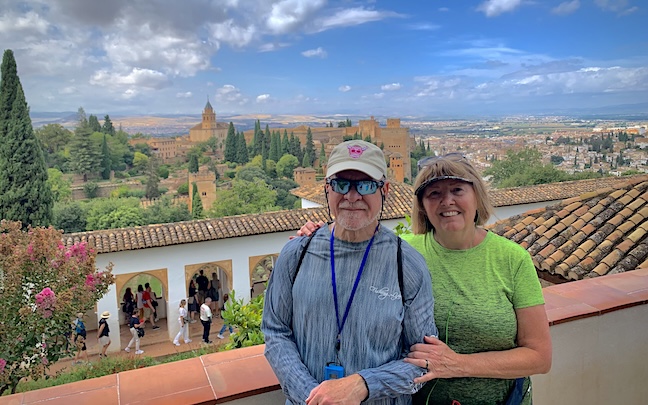
Granada’s 235,000 residents live in tightly packed houses strewn across the Alhambra, Albayzín, and Sacromonte hillsides. The Darro, Genil, Monachil, and Beiro Rivers converge in these foothills at the base of the Sierra Nevada mountains, explaining why this area has been inhabited since 5500 BC. The steep hills and narrow, meandering streets have earned Granada the titles of the World’s seventh least walkable city and Europe’s least walkable city overall. With all the confusing ups and downs and winding around streets, the beautiful and delightful city remains one of the most frequently visited in Spain.

Our Hotel Anacapri is just off Plaza Nueva, the hub for Granada’s main sights, all within a 20-minute walk. Our guide, Agustin Ciriza’s orientation, advises that cabs are cheap and the way is steep if your destination is at the top of a hill. We managed 7.2 thigh-burning miles on our first full day of exploration.

The Alcaicera is the original Arab Bazaar and silk market. The maze of narrow streets was lined with goods and confusing to navigate with the loosely detailed gimme maps available.

All manner of tourist-enticing trinkets, textiles, clothes, foods, jewelry, and doodads spill out of shops, luring shoppers inside where anxious vendors await to part them from their euros.

Conquering Christians built their “Arc de Triomphe” styled church entry on top of the Great Mosque they destroyed, where Muslims had worshiped for 700 years. The new fifteenth-century church took over 200 years to complete.

The Catholic church believes bigger and grander is best to keep its believers humbled and fearful of the powerful god that lives inside these doors. Ironically, the beautiful carving was done by Muslim craftsmen.

The Cathedral has five naves, which make the church’s base rectangular. The main nave is 113 feet tall, with stained glass windows around the vault and gold stars on a blue field in the dome.

Many of the fifteenth-century stained glass masterpieces are placed high in the Cathedral’s towers. The artwork is hard to appreciate at that height, but the colorful light the stained glass allows to enter creates a beautiful effect.

The Cathedral’s first organ was installed in 1492. In 1521, new organs were placed in the transit, but this epistle organ was built in 1749 by Leonardo Avila. The keys are ebony and ivory, and dummy pipes were added to fill out the showy twin fronts.

The Granada Cathedral is impressive, but the massive Alhambra Palace and fortress complex is one of Spain’s top attractions and the most famous example of Islamic architecture. Building the sprawling compound began in 1238, and additions were made by various residents and rulers up to the 17th century. It is a UNESCO World Heritage Site.

Perched high on a hill, the Alhambra was a self-contained city looming above the rest of Granada. The Alhambra grounds are 2,430 feet long, 670 feet at the widest point, and cover 35 acres. Moorish-designed buildings were meant to be seen within, keeping the exteriors simple and functional.

Water was scarce and invaluable in the North African deserts where the Islamic Moors came from to conquer Spain in 711 AD. In Islam, water is the purest symbol of life, and the Moors lavishly displayed their water wealth in the Alhambra’s courtyards, gardens, and fountains.

Picturesque openings in rooms, walkways, and terraces featured lavish gardens in the foreground and grand views from the Alhambra’s lofty perch in the distance.

Maze-like hedges and exotic plants imported from all over the world offered respite and peaceful surroundings for the royal inhabitants to enjoy, entertain guests, or conduct meetings without leaving the protected grounds.

Elaborate hedges and plant sculptures mirrored the essential elements of Islamic Architecture.

Intricately formed plaster stucco “stalactites” adorned the inner domes, their elaborate colors faded with the passing centuries. Scalloped windows, and repeating patterns and prayers etched into the walls, fired into tilework, and carved into exotic exposed woods adorned nearly every exposed surface.

Above, we are standing in the dry pool that would have surrounded “The Fountain of Lions” made of carved marble. “Watch your step” was a constant caution from our local guide, as the floors were randomly uneven and often channeled in meeting rooms and courtyards for water to flow.

One of the few surviving pieces of ancient furniture is the “King’s Chair.” Its simple and sturdy design has survived the test of time and was the only seat guests were allowed to sit on. It fit me well. Gazing at the dizzying array of symbols and patterns, I channeled my grandmother’s thought, “That’s way too busy.”

The main Alhambra sights are the Palace of Charles V, Alcazaba Fort, Palacios Nazaries, Partal Gardens, the General Life, and its gardens. The Alhambra attracts 8,000 visitors a day. You must make reservations far in advance. Tickets come with a strict 30-minute time slot, but you can come and go all day after meeting that restriction. We had a local guide who took us to the must-see locations in an order that kept us out of the main tourist masses. I would strongly advise hiring local knowledge to fully appreciate this massive marvel of historic architecture and grandeur.

